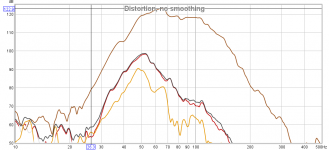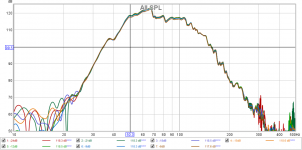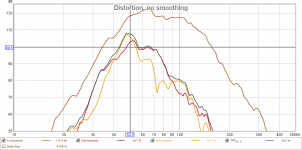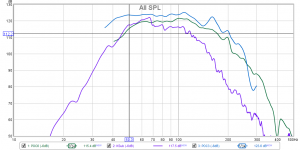That second response for the 380 looks more like what I would expect from a accordion surround woofer vs the rubber surround. Thanks for that.
The response curve is primarily dictated here by the strong motor and the highish Le. Measured Le for the PA310 was a bit lower than published though, and I'm hoping for the same with the PA380.
If I get time I'll try starting with your cab and maybe increasing size a tad to move the bump lower.
I've attached a copy of the workbook I used to make the sim. It might make it a bit easier to come up with a different alignment.
Attachments
A KSub won't hit 130dB unless there's a peak in the midrange and someone's opened it up and bypassed the crossover. That said, it should still make a reasonable thump. If they can use that long-term, it's by far the cheapest option.
Yes, I'm resurrecting an old thread. Ok, it's not that old, but the requirements remain the same. The KSubs were put into use in the bar, but now the bar is now under a new name and being rebuilt as a larger bar.
Well, i managed to get my hands on one of the KSubs, and perform a few measurements. I'm not really impressed, and I'm wondering if something's wrong with the sub. At 108dB output, measured about 6 inches from its "vents", distortion is already at 10% in the passband, and there's lots of 3rd order HD too, not something I'd expect from a 12x2 4th order BP system. The built-in amp was nowhere near to clipping at that output level.
QSC calls it a bandpass sub, but the vent seems a bit too large for the front of the enclosure to act as a proper bandpass filter, so I suspect that the rapid rolloff about 100 Hz is more electrical than acoustical in nature, and it would explain the higher 3rd order HD than I expected.
Maybe one or both of the drivers is shot? I'm tempted to pull the amp out of the enclosure tomorrow and do a DATS run against each driver to see it turns up anything.
Attachments
Brian,Well, i managed to get my hands on one of the KSubs, and perform a few measurements. I'm not really impressed, and I'm wondering if something's wrong with the sub. At 108dB output, measured about 6 inches from its "vents", distortion is already at 10% in the passband, and there's lots of 3rd order HD too, not something I'd expect from a 12x2 4th order BP system.
Maybe one or both of the drivers is shot?
If I'm reading your chart correctly, it seems to be about what I'd expect from the KSub at one meter half space outdoors at or near full output, though you don't specify anything about test conditions for the chart. The spec rating of "130dB peak" certainly would not happen near either end of it's rated -6dB down points of 48-134 Hz, and would have to be a very short peak ;^)
The chart shows the distortion down around -22 dB from 120dB at 50Hz, about 7.94%. The distortion response at 100 Hz is more than 40 dB down, <1%.
That does not seem to correspond with your statement "At 108dB output, measured about 6 inches from its "vents", distortion is already at 10% in the passband", perhaps at 6" there was enough vent velocity to clip the test mic?
Hmm, the graph is a bit misleading, perhaps I should have included the legend. I'd run a linearity test on the KSub, which involved basically measuring its output at different input levels and offsetting the measured data to compensate (e.g. at -24dB, I'd offset the measurement by 24dB in REW, at -21dB I'd add 21dB, etc.). This way makes it very easy to see any changes in linearity in REW, as these changes can both be seen in the graph and read of the legend. When I switched to distortion measurements, I didn't remove the offset.
The actual measured distortion at the level that produced the 122dB peak was just below 30%, and no the mic wasn't clipping. And this was with the Deep Mode option off. When switched on, the distortion got considerably worse.
In comparison, under more difficult measuring conditions my POC6 hit 9.6% in its passband, and that was primarily 2nd order HD (3rd order HD as just 2.8% at that point). The POC3.1 (basically POC3 loaded with the Eminence Kappalite 12" driver) measured even better. OTOH, the KSub's THD sloped down quite a bit from the peak at 50 Hz, possibly due to the its bandpass design. Unfortunately REW does not allow direct comparison of THD measurements.
This KSub is a well-used one, and the high distortion might just be a side-effect of the abuse that it's seen over its lifetime. I didn't have enough time with it do a direct comparison between it and the DIY subs I had on hand.
The last chart shows a comparison between the three subs. The SPL levels are not directly comparable, as they were taken under different conditions, and the KSub is active while the two POCs are passive. There was also a 200 Hz LP filter on the output of the POC subs. But from the graph, it looks like POC6 gets almost as low as the KSub, and POC3.1 gets quite a bit lower.
The actual measured distortion at the level that produced the 122dB peak was just below 30%, and no the mic wasn't clipping. And this was with the Deep Mode option off. When switched on, the distortion got considerably worse.
In comparison, under more difficult measuring conditions my POC6 hit 9.6% in its passband, and that was primarily 2nd order HD (3rd order HD as just 2.8% at that point). The POC3.1 (basically POC3 loaded with the Eminence Kappalite 12" driver) measured even better. OTOH, the KSub's THD sloped down quite a bit from the peak at 50 Hz, possibly due to the its bandpass design. Unfortunately REW does not allow direct comparison of THD measurements.
This KSub is a well-used one, and the high distortion might just be a side-effect of the abuse that it's seen over its lifetime. I didn't have enough time with it do a direct comparison between it and the DIY subs I had on hand.
The last chart shows a comparison between the three subs. The SPL levels are not directly comparable, as they were taken under different conditions, and the KSub is active while the two POCs are passive. There was also a 200 Hz LP filter on the output of the POC subs. But from the graph, it looks like POC6 gets almost as low as the KSub, and POC3.1 gets quite a bit lower.
Attachments
The spec rating of "130dB peak" certainly would not happen near either end of it's rated -6dB down points of 48-134 Hz, and would have to be a very short peak ;^)
Some reading for those interested: Spec Wars: Looking Inside Loudspeaker SPL Specifications - ProSoundWeb
I spoke with someone else in the industry more recently, who revealed a way that another major manufacturer tests their cabs:
- Play the test signal, and push the fader up and up and up. Keep going until the SPL reading won't get any higher. Doesn't matter how much clipping or distortion there is.
- When the speaker fails, replace it.
- Go through about 10 test cabs.
- Claim that your 15" coaxial stage monitor will do 143dB.
I wish I was kidding.
The MaxSPL figure might as well be telling us how loud the speaker is when it hits the ground after being dropped from a tall building.
Chris
Some reading for those interested: Spec Wars: Looking Inside Loudspeaker SPL Specifications - ProSoundWeb
Sounds like the need for independent testing and a proper standard, e.g. average SPL at the point where distortion in the design passband peaks at a specific level, e.g. 10%.
Sounds like the need for independent testing and a proper standard, e.g. average SPL at the point where distortion in the design passband peaks at a specific level, e.g. 10%.
Nice idea, but we're more tolerant to distortion at LF or VHF. Who's gonna hear 10% THD at 10kHz, or care about 10% THD at 100Hz?
You could maybe come up with a weighting curve, but then there's endless debate on that, too.
I did have a few people (including some tech guys quite high up in some big companies) agreeing with me that a proper test standard would be better, but finding something that everyone can agree on is a huge problem.
Chris
Nice idea, but we're more tolerant to distortion at LF or VHF. Who's gonna hear 10% THD at 10kHz, or care about 10% THD at 100Hz?
...and don't forget that odd-order HD is a lot more annoying than even-order HD, so a DUT displaying primarily odd-order HD is going to sound worse than a DU displaying primarily even-order HD.
In any case, similar to amplifier specifications, it should be more about establishing a benchmark, rather than relating the measurements directly to what we hear, which varies from individual to individual anyway. And if it's done independently, that removes the need for the various manufacturers to "agree".
THD measurements are pretty easy to do these days with tools like REW. I'm actually a bit surprised that many of the "reviews" I see for pro sound speakers don't include THD measurements.
- Status
- This old topic is closed. If you want to reopen this topic, contact a moderator using the "Report Post" button.
- Home
- Loudspeakers
- Subwoofers
- Cheap sub for Mackie Thump12s....



